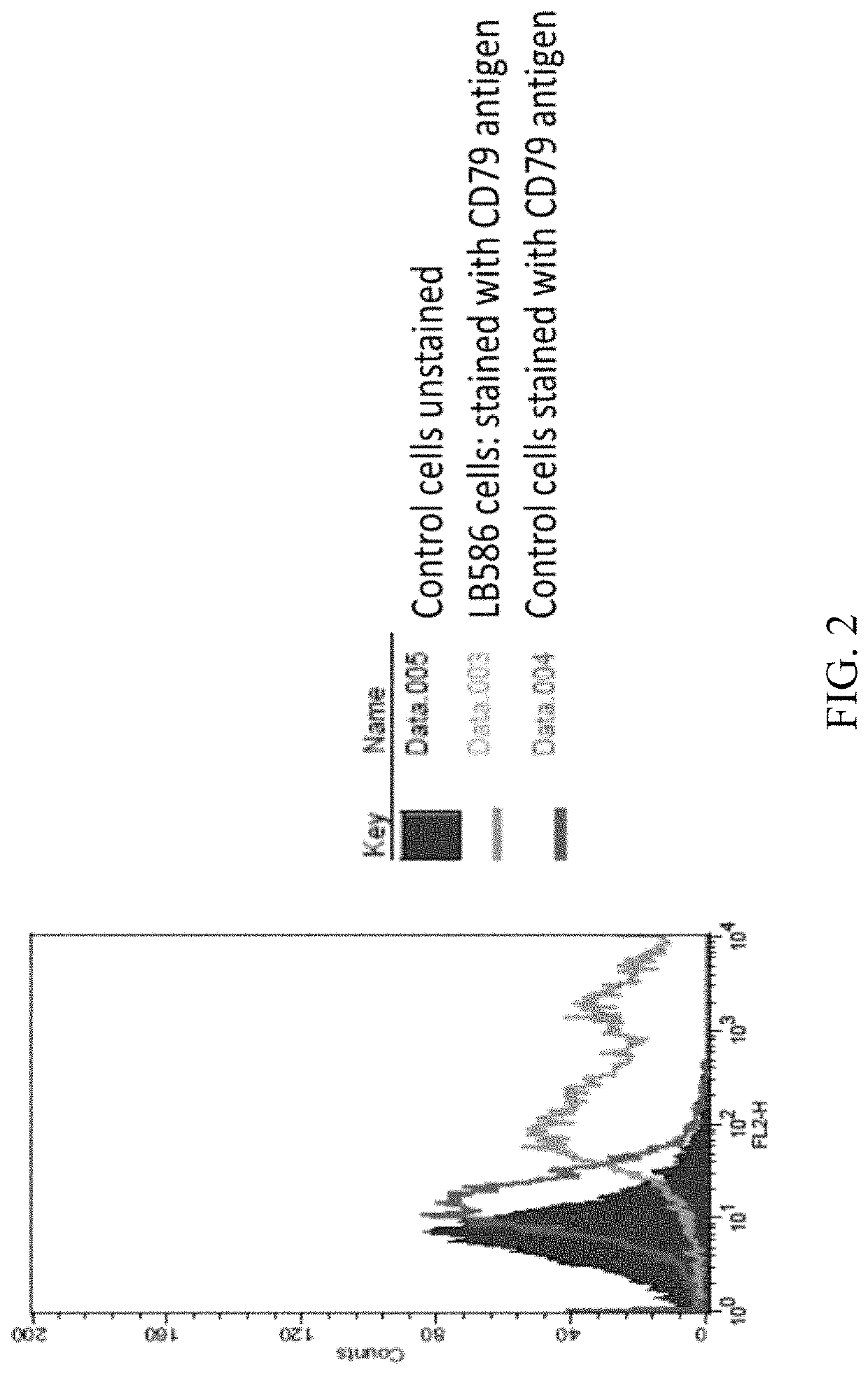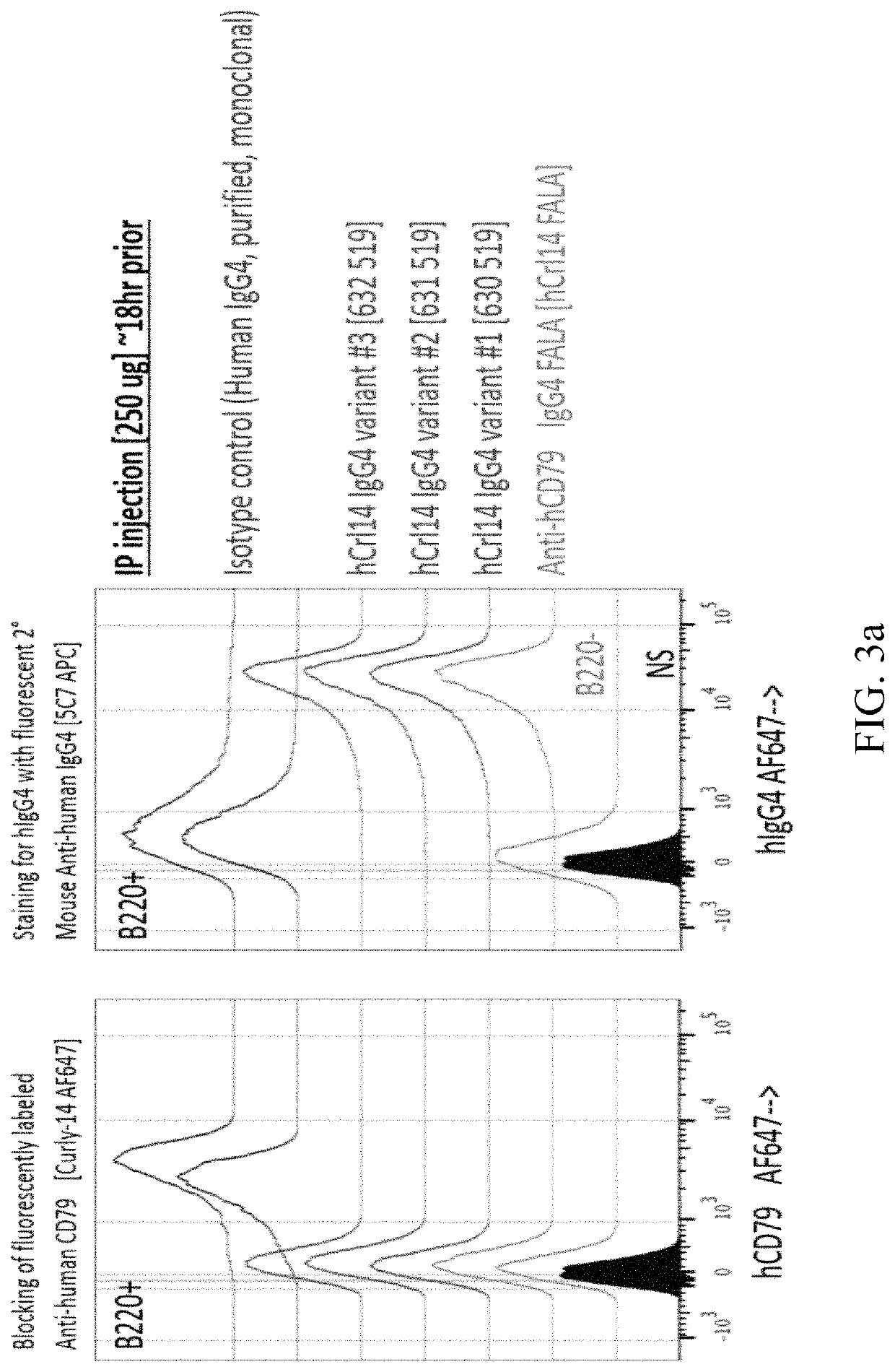Anti-CD79 antibodies and their uses
a technology of anti-cd79 antibodies and anti-cd79, which is applied in the field of anti-cd79 antibodies, can solve the problems of opportunistic infections, adverse effects of existing standard-of-care therapies, etc., and achieve the effects of increasing or decreasing the effector function of antibodies, reducing the serum half-life, and increasing or decreasing the serum half-life of antibodies
- Summary
- Abstract
- Description
- Claims
- Application Information
AI Technical Summary
Benefits of technology
Problems solved by technology
Method used
Image
Examples
example 1
of Chimeric Anti-CD79 Antibodies
[0277]A chimeric antibody HcLc was created from a mouse antibody that binds to CD79 with high specificity and high affinity. The VH domain and the VL domain of a mouse antibody (SEQ ID NOs: 1 and 2) were fused to human IgG2 CH1, CH2 and CH3 domains or a human kappa CL domain, respectively.
example 2
of Humanized Anti-CD79 Antibodies
[0278]The mouse antibody that binds CD79 was also humanized. The CDRs of the heavy chain (IgG1) and the light chain (kappa) SEQ ID NOs: 3-8 were grafted to acceptor human framework sequences. Three of these CDRs (CDR-L1, CDR-L2, and CDR-H2) contain amino acid motifs (DG, DS, and NG) that can be undesirable. A different CDR-L1 is used with KSSQSLLDSSGKTYLN (SEQ ID NO: 57), and two different CDR-H2s are used with RIYPENGDTNYAGKFKG (SEQ ID NO: 58), or RIYPESGDTNYAGKFKG (SEQ ID NO: 59). In addition, certain framework amino acid residues of mouse antibody were retained, including amino acids that are immediately adjacent to a CDR sequence-wise or are predicted to be within about 3 Å of a CDR in a 3D immunoglobulin model and may contact the antigen and support binding of the CDR to the antigen. Roughly about three mouse framework amino acid residues adjacent to a CDR were retained.
[0279]Human framework sequences were selected by aligning the mouse framewor...
example 3
Maturation of Humanized Antibody H1L2 (LB495 / PRI47, SEQ ID NOs: 9 and 19)
[0283]The humanized antibody H1L2 (SEQ ID NOs: 9 and 19) was affinity matured. Four phage display libraries were made, two from the heavy chain H1 (SEQ ID NO: 10) and two from the light chain L2 (SEQ ID NO: 20). Saturation mutagenesis was performed on the CDR3 to make CDR3 heavy and CDR3 light chain libraries, and error prone PCR was also used to randomly mutagenize each the H1 heavy and the L2 light chain to make a heavy chain library and a light chain library. Each heavy chain library was combined with the parent light chain L2 (SEQ ID NO: 19), and each light chain library was paired with the parent heavy chain H1 (SEQ ID NO: 9) to make phage display libraries of candidates for affinity maturation. Each library was panned against CD79 in a competition assay with the parent H1L2 antibody, and binding clones obtained in the panning were tested for affinity in an ELISA. A VH clone with a mutation in CDR3 (SEQ ID...
PUM
| Property | Measurement | Unit |
|---|---|---|
| temperature | aaaaa | aaaaa |
| temperature | aaaaa | aaaaa |
| temperature | aaaaa | aaaaa |
Abstract
Description
Claims
Application Information
 Login to View More
Login to View More - R&D Engineer
- R&D Manager
- IP Professional
- Industry Leading Data Capabilities
- Powerful AI technology
- Patent DNA Extraction
Browse by: Latest US Patents, China's latest patents, Technical Efficacy Thesaurus, Application Domain, Technology Topic, Popular Technical Reports.
© 2024 PatSnap. All rights reserved.Legal|Privacy policy|Modern Slavery Act Transparency Statement|Sitemap|About US| Contact US: help@patsnap.com










